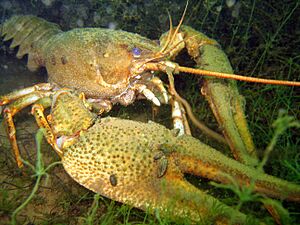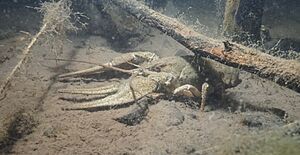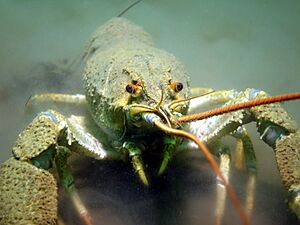Danube crayfish facts for kids
Quick facts for kids Pontastacus leptodactylus |
|
|---|---|
 |
|
| Conservation status | |
| Scientific classification | |
| Genus: |
Pontastacus
|
| Species: |
leptodactylus
|
| Synonyms | |
|
|
The narrow-clawed crayfish, also known as the Danube crayfish or Turkish crayfish, is a type of crayfish. It's quite big and important for people in some areas. Its scientific name is Pontastacus leptodactylus.
This crayfish naturally lives in fresh and slightly salty (called brackish water) areas. You can find it in eastern Europe and western Asia. This includes places near the Black Sea and big rivers like the Danube, Dnieper, Don, and Volga. It also lives in water systems in Turkey.
Since the 1700s, this crayfish has spread to many new places. It first moved through canals built in western Russia. Later, in the 1900s, people introduced it to many regions. They did this mainly so people could eat them. Today, you can find the narrow-clawed crayfish all over Europe.
Contents
What Does the Narrow-Clawed Crayfish Look Like?
The narrow-clawed crayfish can grow up to 30 centimeters (about 12 inches) long. This is measured from its snout (rostrum) to the end of its tail (telson). However, most of them are usually around 15 centimeters (about 6 inches) long.
Body and Color
The sides of its main body, called the thorax, feel very rough. Their color is usually a pale yellow or light green. The crayfish has two sets of small ridges behind its eyes. The second set might even have tiny spines. It also has a noticeable bump on the "shoulder" of its shell, called the carapace.
Claws and Distinguishing Features
As its name suggests, the narrow-clawed crayfish has long and thin claws. The top part of their claws is rough, and the bottom part is the same color as their body. There's also a small bump on the fixed part of the claw.
You can tell the narrow-clawed crayfish apart from the European crayfish (Astacus astacus) by looking at their claws. The narrow-clawed crayfish has much thinner "fingers" on its claws.
Health and Sickness
Scientists have studied the narrow-clawed crayfish and found that they can sometimes get sick. They can even have two or more different types of germs (pathogens) inside them at the same time. For example, one study found that some crayfish had both bacteria and a type of fungus.
Where Do Narrow-Clawed Crayfish Live?
The narrow-clawed crayfish is generally a calm animal. This is especially true for the males, even though they have large claws. They prefer calm fresh water or slightly salty water. This includes places like lakes, lagoons, and canals. They can also live in rivers where the water moves.
The IUCN Red List is a list that shows how endangered different species are. The narrow-clawed crayfish is listed as a species of "Least Concern." This means that it is not currently in danger of disappearing.




